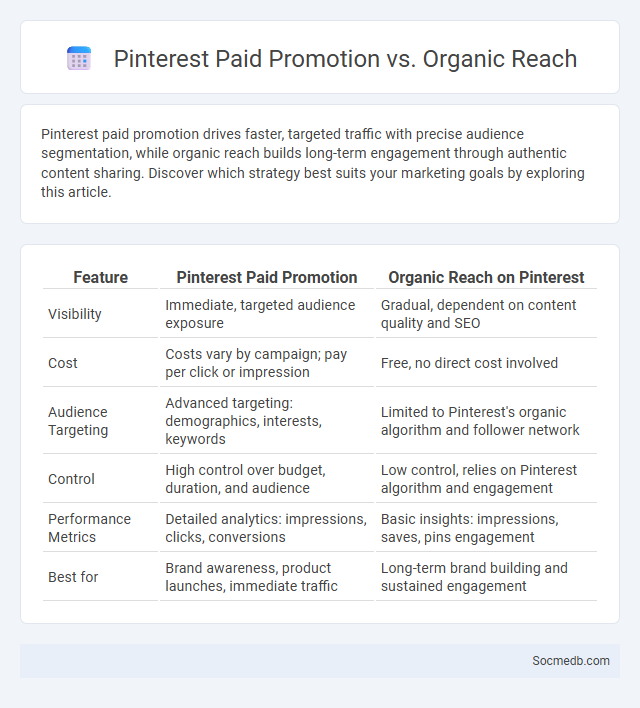
Photo illustration: Pinterest Paid Promotion vs Organic Reach
Pinterest paid promotion drives faster, targeted traffic with precise audience segmentation, while organic reach builds long-term engagement through authentic content sharing. Discover which strategy best suits your marketing goals by exploring this article.
Table of Comparison
| Feature | Pinterest Paid Promotion | Organic Reach on Pinterest |
|---|---|---|
| Visibility | Immediate, targeted audience exposure | Gradual, dependent on content quality and SEO |
| Cost | Costs vary by campaign; pay per click or impression | Free, no direct cost involved |
| Audience Targeting | Advanced targeting: demographics, interests, keywords | Limited to Pinterest's organic algorithm and follower network |
| Control | High control over budget, duration, and audience | Low control, relies on Pinterest algorithm and engagement |
| Performance Metrics | Detailed analytics: impressions, clicks, conversions | Basic insights: impressions, saves, pins engagement |
| Best for | Brand awareness, product launches, immediate traffic | Long-term brand building and sustained engagement |
Introduction to Pinterest Marketing
Pinterest marketing leverages a highly visual platform where over 450 million active users seek inspiration and ideas. Your brand can tap into targeted keywords and rich pins to increase discoverability and drive website traffic effectively. Harnessing Pinterest's unique algorithm optimizes content visibility, boosting engagement and conversions for your business.
Understanding Organic Reach on Pinterest
Organic reach on Pinterest reflects the number of unique users who see your pins without paid promotion, highlighting the platform's algorithm-driven content discovery. Key factors influencing organic reach include pin quality, keyword optimization, and user engagement such as repins and comments. Consistently creating relevant, visually appealing pins that align with trending topics and niche interests enhances visibility and drives sustained organic traffic.
What Is Pinterest Paid Promotion?
Pinterest Paid Promotion refers to a targeted advertising method where businesses pay to display their pins to a specific audience based on interests, demographics, and behaviors. This service enhances brand visibility and drives traffic by placing sponsored pins in users' home feeds, category feeds, and search results. Advertisers can optimize campaigns with Pinterest's analytics tools to increase engagement and conversion rates.
Key Differences: Organic Reach vs Paid Promotion
Organic reach on social media refers to the number of people who see your content naturally, without paid advertising, relying on platform algorithms and user engagement. Paid promotion involves investing in advertisements to target specific audiences, ensuring greater visibility beyond your current followers. Understanding these key differences helps you optimize your marketing strategy by balancing budget and audience engagement effectively.
Benefits of Relying on Organic Reach
Organic reach on social media enhances authentic engagement by connecting brands with genuinely interested audiences without incurring advertising costs. Leveraging organic content builds trust and long-term relationships, as users interact based on value and relevance rather than paid promotion. Consistent organic reach also improves algorithmic favorability, increasing visibility and potential follower growth over time.
Advantages of Pinterest Paid Promotion
Pinterest Paid Promotion offers your brand enhanced visibility by targeting specific audiences interested in your products or services, driving more qualified traffic to your website. It leverages visual discovery and search intent, increasing engagement through promoted pins that seamlessly blend with organic content. Businesses benefit from measurable ROI and detailed analytics, allowing you to optimize campaigns for better performance and increased conversions.
Cost Analysis: Paid Promotion vs Organic Strategies
Paid promotion on social media offers immediate visibility and targeted audience reach with clear budget control but often incurs significant costs that scale with campaign goals. Organic strategies rely on consistent content creation and community engagement to build trust and long-term audience growth without direct payments, though results take longer to materialize. Businesses must analyze return on investment (ROI) by comparing acquisition costs, engagement rates, and conversion metrics between paid ads and organic efforts to optimize marketing spend efficiently.
Performance Metrics: Measuring Success
Tracking key performance metrics such as engagement rate, click-through rate, and conversion rate is essential for evaluating the effectiveness of your social media campaigns. These metrics provide valuable insights into audience behavior, content resonance, and overall ROI. By analyzing these data points, you can optimize strategies to enhance reach and drive measurable success.
Best Practices for Combining Organic and Paid Efforts
Leveraging both organic content and paid campaigns on social media ensures maximum reach and engagement by targeting diverse audience segments effectively. Your strategy should prioritize high-quality, authentic organic posts that build trust and community, while using paid ads to amplify key messages and drive conversions. Balancing analytics insights from both approaches enables continuous optimization for improved ROI and brand visibility.
Which Pinterest Strategy Is Right for Your Business?
Choosing the right Pinterest strategy for your business depends on your target audience, content type, and marketing goals. Businesses focused on visual branding and product discovery benefit from creating engaging, high-quality Pins optimized with relevant keywords and rich descriptions. Incorporating Pinterest SEO techniques and leveraging Idea Pins can drive traffic, increase brand visibility, and boost conversions effectively.
 socmedb.com
socmedb.com